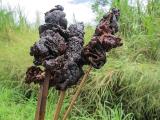Jun 10, 2002 (CIDRAP News) The smallpox virus has a protein that inhibits the human complement system far more effectively than does its counterpart protein in the closely related vaccinia virus, used in smallpox vaccine, according to researchers who compared the two proteins. This difference may be an important reason for the virulence of smallpox and may offer an avenue for research on treatments, they suggest.
The research team, led by Ariella M. Rosengard of the University of Pittsburgh, molecularly engineered and analyzed what they call "smallpox inhibitor of complement enzymes," or SPICE. They compared this with its homologue in the vaccinia virusvaccinia virus complement control protein, or VCP. SPICE is nearly 100 times more potent than VCP in inactivating a key complement component, the researchers write in the Proceedings of the National Academy of Sciences.
Variola (smallpox) virus is not available to researchers, but the crystal structure of VCP was recently described, and this made it possible for the researchers to synthesize SPICE, the article says. "We generated the SPICE coding sequence from that of VCP by site-directed mutagenesis of 13 VCP nucleotides, which resulted in 11 aa [amino acid] substitutions, consistent with the predicted amino acid sequence of SPICE," the authors write. Recombinant SPICE and VCP proteins then were produced in mammalian and insect cells. Human complement components C3b and C4b then were incubated with SPICE, VCP, and other complement regulatory proteins.
The authors found that SPICE was nearly 100 times faster than VCP in degrading C3b and six times faster than VCP in breaking down C4b. "Because SPICE efficiently inhibits the stability of human C3b and C4b, it essentially inactivates the convertases and, therefore, both the classical and alternative pathways of complement," the report says. "Consequently, the production of the inflammatory mediators C3a, C4a, and C5a is also decreased. Therefore, the purpose of SPICE may be to create a microenvironment around variola-infected cells to protect them from complement-mediated attack while they serve as a site of viral replication."
To study whether the effect of SPICE is specific to human complement, the experimenters also compared the ability of SPICE and VCP to inhibit complement from humans, dogs, guinea pigs, and baboons. Because erythrocytes are lysed in the presence of an increasing amount of complement, the test was done by individually placing the two proteins, along with sheep or rabbit erythrocytes, in blood serum samples from the four species and then measuring the extent of hemolysis.
The results showed that SPICE and VCP both inhibited complement, but SPICE preferentially inhibited human and baboon complement, whereas VCP preferentially inhibited dog and guinea pig complement. "The fact that SPICE functions better against human complement quantitatively and qualitatively demonstrates that variola exhibits human preference at the protein level, a concept previously suggested, but not shown," the report states.
The authors also remark that the relatively poor ability of VCP to inhibit human C3b and C4b suggests one reason vaccinia makes a relatively safe and effective smallpox vaccine.
The report concludes, "Assuming that complement is as critical to orthopoxvirus containment in humans as it is in rodents, SPICE seems to be a virulence factor for variola virus. Thus, the disabling of SPICE could represent an approach to the treatment of smallpox. In addition, the disabling of VCP could represent an approach to developing a safer smallpox vaccine."
Rosengard AM, Liu Y, Zhiping N, et al. Variola virus immune evasion design: expression of a highly efficient inhibitor of human complement. Proc Nat Acad Sci 2002 (published online before print, May 28)
Abstract


















